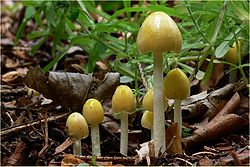From Wikipedia
Open on Wikipedia
| Bolbitius titubans | |
|---|---|

| |
| Scientific classification | |
| Kingdom: | Fungi |
| Division: | Basidiomycota |
| Class: | Agaricomycetes |
| Order: | Agaricales |
| Family: | Bolbitiaceae |
| Genus: | Bolbitius |
| Species: | B. titubans
|
| Binomial name | |
| Bolbitius titubans (Bull.) Fr.
| |
| Synonyms | |
| Bolbitius titubans | |
|---|---|
| Mycological characteristics | |
| Gills on hymenium | |
| Cap is ovate or flat | |
| Hymenium is adnate or free | |
| Stipe is bare | |
| Spore print is brown | |
| Ecology is saprotrophic | |
| Edibility is edible, but unpalatable | |
Bolbitius titubans, also known as Bolbitius vitellinus, and commonly known as the sunny side up,[1][2] is a widespread species of mushroom found in North America. It grows on grass and dung.
Description
[edit]The mushroom cap is 1.5–7 centimetres (1⁄2–3 in) across,[3] and grows from egg-shaped when young to broadly convex, finally ending up nearly flat.[4] The cap's color starts yellow or bright yellow, and fades to whitish or greyish with age.[5] The stem is 3–12 cm (1–4+1⁄2 in) tall and 2–6 millimetres (1⁄8–1⁄4 in) wide,[3] whitish-yellow with a fine mealy powdering, and very delicate.[6]
The fragile and soft gills are free from the stem or narrowly attached and fade from whitish or pale yellowish to rusty cinnamon with age.[4] They produce a rusty-brown spore print.[7] The spores are brown, elliptical, and smooth.[3]
Similar species
[edit]Similar species include Bolbitius aleuriatus,[3] B. coprophilus, B. lacteus, and Conocybe apala.[7]
Habitat and distribution
[edit]The species grows on grass, woodchips, compost, and dung. It is ubiquitous in North America[7] and Europe.
Edibility
[edit]The mushroom's edibility is unknown.[3] While nonpoisonous,[8] it is too small to be worthwhile.[3]
References
[edit]- ^ Arora, David (1986) [1979]. Mushrooms Demystified: A Comprehensive Guide to the Fleshy Fungi (2nd ed.). Berkeley, CA: Ten Speed Press. pp. 474–75. ISBN 978-0-89815-170-1.
- ^ Siegel, Noah; Schwarz, Christian (September 1, 2024). Mushrooms of Cascadia: A Comprehensive Guide to Fungi of the Pacific Northwest. Humboldt County, CA: Backcountry Press. p. 150. ISBN 9781941624197.
- ^ a b c d e f Davis, R. Michael; Sommer, Robert; Menge, John A. (2012). Field Guide to Mushrooms of Western North America. Berkeley: University of California Press. p. 248. ISBN 978-0-520-95360-4. OCLC 797915861.
- ^ a b Kuo, Michael (February 2012). "Bolbitius titubans". Retrieved October 31, 2013.
- ^ "California Fungi—Bolbitius titubans". Retrieved October 31, 2013.
- ^ "Rogers Mushrooms — Bolbitus vitellinus Mushroom". Archived from the original on December 5, 2008. Retrieved October 31, 2013.
- ^ a b c Audubon (2023). Mushrooms of North America. Knopf. p. 628. ISBN 978-0-593-31998-7.
- ^ Miller Jr., Orson K.; Miller, Hope H. (2006). North American Mushrooms: A Field Guide to Edible and Inedible Fungi. Guilford, CN: FalconGuide. p. 270. ISBN 978-0-7627-3109-1.